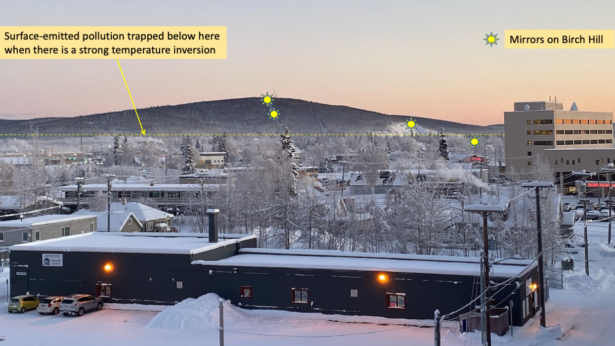By Jochen Stutz, Meeta Cesler-Maloney, and Bill Simpson
Fairbanks and North Pole residents know that temperature inversions trap pollution in a shallow layer near the ground, leading to poor air quality. Meteorologists know a lot about the inversion, but the depth of the polluted layer was first documented with pollution measurements made last winter as part of the Fairbanks Winter Air Study. In this study, four dozen international researchers came to Fairbanks to study pollution in the North.
Temperature inversions are conditions where warmer, less-dense, air sits atop a denser pool of colder air.
Wind usually pushes out the dirty air and allows cleaner air to move in. During an inversion, however, the winds aloft ride over the pool of cold air and trap pollution in a shallow layer. Bigger temperature differences lead to stronger inversions, which more efficiently trap air at the surface. Trees and buildings also often stop the wind near ground level, making the situation worse.
In a temperature inversion, anything we emit into the surface air builds up. Pollution can soon reach unhealthy levels.
Understanding the depth of this polluted layer is critical because the shallower it is, the more concentrated the pollution becomes. To address this question, we used a unique instrument that can vertically profile the pollution layer over Fairbanks.
We set up this searchlight-like instrument in the downtown Fairbanks parking garage. This instrument shone light through the air to mirrors placed at different heights on Birch Hill, profiling more than 600 feet above the valley floor. The photo shows the locations of the mirrors as stars. Since pollution absorbs certain colors of light, analyzing the light returned from a mirror can be used to measure the concentration of pollution.
We found that pollution concentrations in the lowest light path, about 50 feet above the valley floor, agreed with the ground-based pollution monitors, indicating that path is in the surface polluted layer. However, we found that when there was a strong inversion, there were much lower pollutant concentrations when viewing on the next lowest path, which had the mirror at 250 feet above the valley floor. Analysis of these measurements showed that the polluted layer is only 100 to 200 feet thick during a strong inversion event.
It’s kind of amazing to think that on a typical quarter-acre downtown lot you can usually walk 100 feet and not leave your property, but that’s the vertical scale of pollution trapping caused by our temperature inversions. Since the surface air is typically stagnant during these inversion conditions, pollution only slowly drifts away horizontally.
This extreme trapping means that when it is a bad air day, it is even more important to minimize how much pollution we emit. The Alaska Department of Environmental Conservation watches the meteorological situation and predicts when the pollution will be trapped, at which point they call an air alert.
During these air alerts, people living in the non-attainment area who do not have a waiver or a No Other Adequate Source of Heat (NOASH) permit cannot use cordwood or pellet stoves and are required to shift to other forms of heat that emit much less fine particulate matter (PM2.5) than wood heat. These alerts, along with burning dry wood, replacement with better stoves or conversion to less-polluting oil or gas, are probably the reason we have cut peak pollution PM2.5 concentrations in half in the last decade.
This study showed that when there is a bad air day, surface-emitted pollution is trapped in a shallow layer only 100 to 200 feet deep. This shallow depth is probably caused by the geography of the Fairbanks bowl, the lack of major winds due to surrounding mountain ranges and the clear skies we get in winter. Because these geographic factors cannot be changed, it is particularly important to heat cleanly on days when the inversion holds the polluted layer to these shallow depths.
Jochen Stutz is an expert from UCLA who visited Fairbanks to carry out this study last winter. Bill Simpson and Meeta Cesler-Maloney are University of Alaska Fairbanks air quality researchers. This work was funded by the National Science Foundation.


